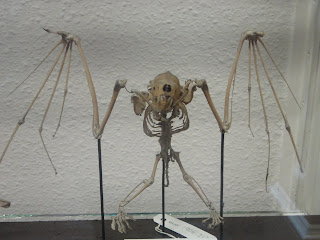Today I went to the Natural History Museum in Dublin.
This museum has on display stuff dead animals and skeletons of animals.
To be short, I didn't like this museum at all. Don't get me wrong, I love animals. My problem with the museum is that I didn't learn anything. When you saw an animal, it just gave you the name of the animal and all this scientific classification of the animal. One would only be able to really appreciate this if you knew about classification of the animal kingdom. So, for someone like me who doesn't have this previous knowledge, it was hard to appreciate the museum.
The vibe of the museum was off as well. Death was every where. The museum just seemed like such a sad place. Needless to say, we didn't stay long there.
The pictures that I took there were of different animals that I found interesting. It would be very boring just to tell you what animal it is. Probably by looking at the picture you would know. So I decided to add some Irish, so you can get something out of the pictures :). Unlike the museum, I want you to learn something! haha.
The earliest traces of Irish language date back to the 4th century. When Christianity became the main religion of Ireland, Old Irish appears on the margins of Latin manuscripts. Middle Irish develops around the 10th century and the 16th century gives birth to Modern Irish.
Irish was the main language spoken in Ireland until the 19th century. The English government prohibited the use of Irish in schools. The Great Famine in the 1840's killed many speakers of the language. It is with the English government and the Great Famine that the decline of the Irish language happened.
It was mostly through the work of Irish Protestants, in the late 1800's, that the revival of the Irish language happened. The Gaelic League and the Gaelic Athletic Association were started in order to promote Irish culture and heritage. More plays were being written about Ireland and the Abbey Theatre was started to promote these new works. Though Irish was not being widely spoken at this time, some of the Irish grammar still remained and these new Irish writers were using Irish grammar with English words in their work.
When Ireland got its independence in 1922, there was a huge government movement to make Irish compulsory to learn. This caused a huge back lash in the community and a lot of people refused to learn it.
Today, the majority of people in Ireland are not fluent in Irish. They do have to studied it in school, but the majority of people use English in their every day conversations.
There are places in Ireland where Irish is the main language. There are special schools were kids are sent to learn Irish.
To me, Irish sounds like German. I think it sounds pretty cool!
Also, many people call the Irish language Gaelic. Gaelic refers to a family of language that can be found in Ireland, Scotland and Wales. To say you speak Irish, you are referring to the Irish branch of Gaelic, if you will.
Below, are the pictures I took at the Natural History Museum. I tried to look up the Irish words of the animals.
 Deer (fia)
Deer (fia)  Cheetah (siota). My favorite animal! Of course it had to be very high and in a spot where I could not get a good picture!
Cheetah (siota). My favorite animal! Of course it had to be very high and in a spot where I could not get a good picture! 

































No comments:
Post a Comment